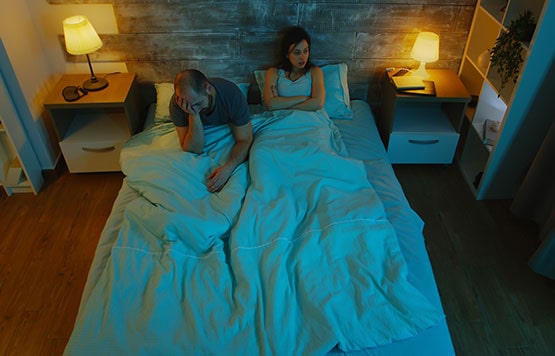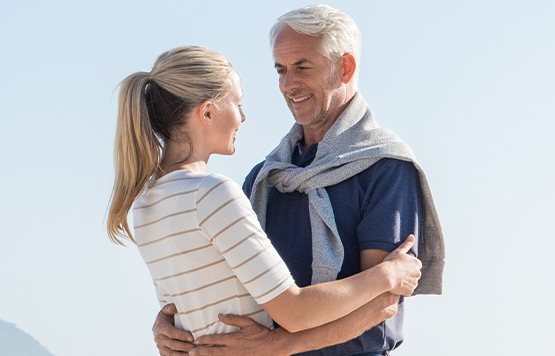We aren't guaranteed much as adults, but if there's one thing we can count on, it's that our bodies change as we get older. For men, that's especially true. One day you're lifting heavy weights and nailing your cardio regimen without having to stretch before or after. And then, in what seems like the blink of an eye, you start to slow down a little. You begin to notice aches and pains in places that weren't there before. You can't just go out for a night on the town, imbibe until your heart is content, and expect to wake up refreshed.
And while headaches and achy joints can be treated with ice and anti-inflammatory medicine, other aspects of aging aren't as easy to treat. You've probably guessed at this point what we're talking about: erectile dysfunction, or ED for short. When brought up to most men, those are two words that cause a guttural reaction of fear and trepidation.
While just about every man fears ED, millions suffer from it - almost 10% of the male population between the ages of 40 and 70. So, if you're beginning to have trouble performing in the heat of the moment, you're definitely not alone. You may be experiencing symptoms like:

Trouble Achieving an Erection

Trouble Maintaining an Erection

Lower Libido

Less Sexual Pleasure

Premature Ejaculation

Inability to Achieve Orgasm
However, at Elite Healthcare Physical Medicine, we understand that stats won't do anything to address the stress and anxiety you're facing in relation to erectile dysfunction. You need a viable solution - a science-backed treatment that doesn't require strange pills or invasive surgeries. As a fully integrated multidisciplinary clinic in Mount Pleasant, we have what you've been searching for: softwave therapy for ED in West Ashley, SC.

To fully grasp the benefits of using soft wave therapy for erectile dysfunction, you must first understand what causes ED to begin with. Put simply, erectile dysfunction is the inability to get an erection and keep it throughout sexual intercourse. You should know that it's not uncommon if you have erection trouble. However, if your inability to "get it up" becomes a common occurrence, you may be suffering from ED.
Erectile dysfunction doesn't just affect your penis - it also affects your wellbeing and relationships. It can lower your confidence, cause a large amount of stress that affects your ability to work, and may even cause contention with your partner.
You hear it all the time - as men get older, they often lose the ability to get erect. But why? As men age, the blood vessels in their penis start to fill up with micro-plaques, causing them to deteriorate. When these blood vessels deteriorate, it's more difficult for them to have steady blood flow. And that's the key to ED - having the constant blood flow to get and keep an erection. That's where the science-backed effectiveness of Softwave therapy swoops in to save the day.
Shockwave technology has been around for decades. It has been used at the highest-level research and medical facilities like the Cleveland Clinic and Memorial Sloan Kettering. However, Softwave therapy is a more refined, effective way to treat erectile dysfunction and also advance tissue healing.
Softwave therapy works by using electrohydraulic spark gap technology at its core. Its innovative design features a parabolic reflector applicator that produces very effective, low-intensity shock waves that are unfocused. Elite Healthcare Physical Medicine's Softwave applicator spreads energy to a large area of both superficial and deep tissue, creating a biological response that kickstarts your body's natural healing process.
For men suffering from ED, it is a revolutionary breakthrough treatment that doesn't require harmful surgeries or side effects from pills. In fact, it has been FDA approved for many uses, including improved blood flow, which is often the root cause of erectile dysfunction.
Book Appointment

Unlike some more traditional treatment options, Softwave therapy gets right to the crux of the ED issue. It uses shock wave technology on a cellular level, helping to naturally heal body parts, like the penis. Some of the most common benefits of Softwave therapy include:
Additionally, Softwave treatments don't require much prep, don't have any sketchy side effects, don't require any numbing agents or anesthesia, and result in little-to-no recovery time. Sound too good to be true? Contact Elite Healthcare Physical Medicine today to learn just how effective Softwave therapy is for our patients!

Softwave therapy works by using efficient, effective shock waves that cause biological regeneration processes that heal your body using its own healing factors. It works like this: Softwaves are created via a high-energy electrical discharge in water. The voltage is discharged between the plus and minus tips of an electrode. The spark gap or arching causes an equalization of voltage between the opposing tips of the electrode, which causes a hot plasma bubble. This bubble explodes and distributes in every direction, compresses the surrounding water, and generates a pressure > 10 MPa within nanoseconds.
To sum up, Softwave therapy uses low-intensity, unfocused energy that is delivered by a reflector in parallel waves. These waves help open up the blood vessels in your penis, allowing more blood to flow. At Elite Healthcare Physical Medicine, our team of expert physicians will develop a personalized Softwave therapy plan based on your body and needs. With the right number of treatments, you should be able to achieve and maintain firm erections as you did in your prime.

A Softwave therapy procedure averages 10-15 minutes but may be longer depending on treatment area and diagnosis. A gel is applied to the surface area to be treated. The applicator produces pulses as the clinician moves around the treatment area. During therapy, communication with your provider is necessary to identify treatment areas and monitor progress.
Once treatment is over, you may resume your normal day-to-day activities. In fact, most patients can have Softwave therapy while on their lunch break. You don't have to worry about recovery time, side effects, or any downtime at all.

More than 50% of men will experience erectile dysfunction at some point in their lives. If you're over the age of 30, have been suffering from ED, and don't want to rely on pills or surgery, Softwave therapy may be for you. That's doubly true if you've tried traditional treatments like Viagra and even surgery but didn't get the results you hoped for. Many academic studies about shockwave therapy for ED state that this revolutionary technology is successful where PDE5 inhibitors fail.
In fact, many urologists consider Softwave therapy the most promising ED treatment on the market. The truth is, even if you're not battling ED, men can use Softwave therapy as a preventative way to keep the magic flowing in the bedroom. Some of the key reasons to choose Softwave therapy over less effective, traditional treatments include:
If you're curious why Softwave treatments are so popular for ED, the answer is simple. Prescription drugs like Cialis and others that "treat" ED often come with less-that-savory side effects. At best, these effects are just something patients have to deal with. At worst, they can disrupt your day-to-day schedule and may prevent you from enjoying a healthy life. Sure, some men swear by the "little blue pill," but most guys aren't aware of the hidden risks with drugs like Viagra. The following side effects can be common in both short and long-term circumstances:
If you're suffering through erectile dysfunction, it's crucial to understand why it's happening. The primary reason for ED is a lack of blood flow to the penis, which makes erections difficult to get and keep. Rather than relying on prescription and gas station pills for a quick fix, more men are using softwave ED treatment in West Ashley, SC for an all-natural solution minus the side effects. With Softwave therapy, you don't have to live with ED, and you don't have to suffer from scary side effects from popping too many pills.
Book Appointment
Softwave therapy is often a more effective solution for men with ED than similar but less effective treatments using pressure waves. Softwave therapy from Elite Healthcare Physical Medicine uses acoustic pulses or unfocused shockwaves with fast and steep rise times and high positive pressure. Our unfocused wave design makes it possible to spread energy to a larger area, which affects deep and superficial tissue. By targeting a larger area, a more potent biological response is often achieved, initiating your body's natural healing factors.
By comparison, radial pressure waves use acoustic pneumatic pulses with low steeping effects, slow rise times, and large negative pressures. Radial waves are shallower than the shockwaves used in Softwave technology and focus energy and pressure at the surface of the applicator.
Here's a quick breakdown of the differences between softwave therapy for ED in West Ashley, SC, and radial pressure waves:

If you're new to the world of Softwave therapy, chances are you've got some lingering questions you need answered. We'll do our best to answer a few of those questions here for your convenience.
Q. Has the FDA approved softwave therapy for ED in cityname, state?
A. Yes - Softwave therapy is FDA 510(k) approved for:
Q. Is softwave therapy painful?
A. Softwave therapy does not require surgery or any invasive form of treatment. With that said, some patients describe minimal discomfort or pain during our softwave treatments. Should this occur, your medical specialist will make necessary adjustments. Usually, patients do not have to endure any pain at all and only experience a pulse or tapping feeling on their skin.
Q. How long is a Softwave treatment session?
A. An individual session only takes five to fifteen minutes. It's typically recommended that patients have treatment once a week for three to five weeks. The length and frequency of your Softwave therapy sessions will be determined after you visit our medical clinic for a comprehensive evaluation.
Q. How long does it take for Softwave therapy to work?
A. Every patient we treat is different, and as such, will have different treatment recommendations. Often, patients notice the results of Softwave therapy after the first session. However, for the longest-lasting effects, most patients need between three and four treatments, with a week of non-treatment after every session.
Q. Can I combine Softwave therapy with other treatments from Elite Healthcare Physical Medicine?
A. It's hard to give a definitive answer to this question since every patient is different. It's important for you to have a full evaluation to determine the scope of your needs and the appropriate therapies. However, Softwave therapy often works very well with other treatments. In fact, other therapies offered at our medical clinic like massage therapy and chiropractic care can make Softwave treatment even more effective.
Remember - our team at Elite Healthcare Physical Medicine is always happy to answer any questions you may have about ED or our ED treatments. Give us a call today - it would be our pleasure to get to know you better!
Unlike some wellness clinics, our experienced providers work together to optimize treatment for men suffering from ED. We always strive to make sexual wellbeing an accessible part of your everyday lifestyle.
That's why, at Elite Healthcare Physical Medicine, our mission is simple: to correct the root cause of your erectile dysfunction by taking a comprehensive, total body approach to healing and treatment. We want to address your ED problem without having to resort to chemical-based medications or unnecessary surgeries. Instead, we focus on all-natural, effective solutions like shockwave therapy for ED in West Ashley, SC.
By discovering what's best for each person's individual body and needs, we can help create a healthier future for those in our community through our holistic physical medicine practices. Contact our office to learn more about Softwave therapy and how we can solve the underlying causes of your unique ED situation.
Book AppointmentCHARLESTON, S.C. (WCIV) — West Ashley is home to South Carolina’s first-ever food forest.Funded through a $50,000 grant from the South Carolina Forestry Commission, Charleston Parks Conservancy launched the project with the City of Charleston and other partners to provide free and nutritious options in areas struggling with food insecurity.“In the end, this will end up producing about 30,000 pounds of fresh organic produce, in a community that doesn't have great access to healthy foods,” said Darlene Hea...
CHARLESTON, S.C. (WCIV) — West Ashley is home to South Carolina’s first-ever food forest.
Funded through a $50,000 grant from the South Carolina Forestry Commission, Charleston Parks Conservancy launched the project with the City of Charleston and other partners to provide free and nutritious options in areas struggling with food insecurity.
“In the end, this will end up producing about 30,000 pounds of fresh organic produce, in a community that doesn't have great access to healthy foods,” said Darlene Heater, executive director of Charleston Parks Conservancy.
Rows of more than 75 plants, ranging from nut trees to berry bushes, line Mulberry Park in West Ashley.
READ MORE: "Hendrick Automotive Group donates $100,000 to Lowcountry Food Bank."
The first in the state, Charleston’s new food forest will provide free, fresh produce to those who need it most.
“What's beautiful about a food forest is that anybody can access it at any time. So, you're not relying on someone's opening hours or the availability to be able to go to a source to get food,” Heater said. “It is in the community and available to the community for whoever needs it.”
The forest features seven tiers of agriculture and will begin producing roughly $25,000 worth of food annually in the first five years.
The conservancy has worked with several local groups, like Slow Food Charleston, to make the flagship project come to life.
“To help bring good, clean, and fair agricultural products to our community, to communities that may not have access to them. To have them engage in a manner that is enriching,” said Kellie Holmes, co-chair of Slow Food Charleston.
READ MORE: "Hansley's Free Fridge project is fighting food insecurity in South Carolina."
Accessibility is at the root of it all.
The food forest is in the Ardmore neighborhood, a lower-income area that could be categorized as a food desert. It isn't an uncommon issue. Around 40.5 million Americans live in USDA-designated food deserts nationwide.
“Mulberry Park is an ideal location. It is a community that, though it has some grocery stores in its vicinity, they are not necessarily grocery stores that everyone in the community can afford to go to,” Heater explained.
Located off the Bikeway, Charleston Parks Conservancy hopes the food forest will feed not only its closest neighbors but the greater West Ashley and Charleston area.
Pluck an apple, cut some herbs or pick some berries at South Carolina's first food forest, a new free-of-charge grove being built in the Ardmore community.With an expected seven stories of canopies and an estimated $25,000 annually in produce by its fifth year, Charleston Parks Conservancy director Darlene Heater acknowledged it's a remarkable undertaking for the local nonprofit."It's creating access ...
Pluck an apple, cut some herbs or pick some berries at South Carolina's first food forest, a new free-of-charge grove being built in the Ardmore community.
With an expected seven stories of canopies and an estimated $25,000 annually in produce by its fifth year, Charleston Parks Conservancy director Darlene Heater acknowledged it's a remarkable undertaking for the local nonprofit.
"It's creating access in food deserts but creating it in a way that is low-maintenance and little barrier for people to be able to participate in it," Heater said.
The food forest on Mulberry Street near Grech Street, and off the West Ashley Bikeway, is being funded by a $50,000 grant from the South Carolina Forestry Commission.
While the conservancy is handling the horticulture, the City of Charleston's parks department is working to excavate the land, add pathways and install a new playground at the park. It is one of several conservancy projects this year, in addition to working with the city to manage 24 parks on the peninsula, on James Island and in West Ashley.
Parks Department director Jason Kronsberg compared the collaboration between the city, the conservancy and the community to a three-legged stool. The conservancy liaises with the neighborhoods, like Ardmore for the food forest, and then fundraises with them before going to the city to bring a project to life.
The food forest is intended to help the Ardmore neighborhood, recently identified in the Charleston parks master plan as a community of high need, along with the surrounding community.
Besides providing free access to produce, the forest can help people better understand where their food comes from, Kronsberg said. It's also an opportunity for folks to lend a hand with some maintenance.
"The parks are owned by everybody," Kronsberg said.
The project will not be without its challenges, though. As the weather in Charleston gets more severe, Heater said that the conservancy will need to tend to the forest carefully and make sure plants or produce don't wash away.
Teaching the community how to use — and not overuse — the one-of-a-kind forest will take time, too.
The conservancy plans to lean on its volunteer base to maintain the forest, such as harvesting, packing and sending excess produce to local nonprofits. There will be no constraints on harvesting to start, as to not adversely impact food accessibility, Heater said. Part of it will be trial and error, and much of the plan is flexible based on the demand the conservancy sees for certain produce.
"What we may learn is that this community really loves sweet potatoes but doesn't care as much about turnips," Heater said. "So let's look at how we can expand growing our sweet potato patch so that we can continue to serve the people adequately who most need it."
This spring will mark the first planting of the fruit trees, brambles and herbs. Heater said that best practices dictate not harvesting during the first year, so by the second year the conservancy expects to have herbs, mushrooms, brambles and possibly bananas to harvest.
By the fifth year, with an estimated 70 trees bearing fruit, Heater said she expects 10,000 pounds of produce.
The food forest comes two years after the adoption of a new Charleston parks master plan and months after the overwhelming approval of a bond referendum question last November.
"Citizens spoke loudly and clearly that they supported the referendum and improved park spaces," Kronsberg said. "Coming out of COVID, when parks became critical infrastructure, it was natural that there was that much support for a referendum."
As the Ardmore food forest begins to yield, relieving supply-chain issues might just become an additional perk. And in a world reshaped after the pandemic, the food forest is one project that shows how to branch out from the traditional park.
There are many challenges to growing fruit, from soil quality to harsh climates for plants and, often, these plantings do not last a particularly long time. Yet there is hope to have fresh fruit in the landscape, and the way this is accomplished is by planting more unique and lesser-known fruit trees and shrubs. One shrub is not only a perfect choice for growing here, but it also has excellent ornamental value as well: the blueberry.
Blueberries are a group of plants usually in the Vaccinium genus, most of which are native to North America. They are members of the Ericaceae family, along with the Rhododendron genus that includes azaleas. There are dozens of species and even more cultivars of blueberries, making selection somewhat confusing.
That being said, there are two main types grown here in the Lowcountry. There is the southern highbush blueberry, V. corymbosum. This group has low chill hour requirements and has decent heat tolerances. Then there is the rabbiteye blueberry, V. virgatum, which is more adaptable to the state and is a perfect choice for the home garden. The rabbiteye blueberry is the preferred species here in the Lowcountry due to its adaptability, productivity and pest tolerance.
As mentioned previously, there is a major consideration when selecting the cultivar of blueberry: chill hour requirements. Chill hours refers to the number of hours below 40 degrees Fahrenheit the plant needs in order for flowers to develop. If the required number of hours is too high, then it would be unlikely the shrub will ever produce flowers or fruits in the Lowcountry. If the required number of hours is too low, then the flowering may commence too early in the year at the first sign of warm weather and thus be damaged by the subsequent frosts. Here, along the coast, the approximate number of hours is 400-600.
The other thing to keep in mind is that, while blueberries are considered self-fertile, fruit production increases with cross-pollination. Rabbiteye blueberries have issues with self-incompatibility, making cross-pollination necessary in order for better fruit development. Ideally, two or more cultivars are required for proper fruit production. Rabbiteye blueberries have the greatest degree of self-incompatibility, whereas southern highbush are better suited to be self-fertile — though it is still recommended to have two or more types.
Growing and maintaining blueberries is relatively simple once they are established, but proper site selection is essential. Blueberry plants prefer well-drained, acidic soil to thrive. These are by far the most common issues with stunted blueberry plants. The pH recommendation for blueberries is between 4.5 and 5.5. A pH above a 6.0 can stunt the plant permanently. It is imperative to have a soil test done before planting to determine the pH. Once a shrub is stunted due to improper pH, the plant generally does not recover.
Pruning when first planted is paramount. This enhances survivability and encourages more vigorous growth the following year. It is also necessary to remove any shoot tips that have flower buds (swollen rounded buds) for the first couple of seasons. This spurs vegetative growth, since reproduction requires tremendous energy.
By the third season, there should be a multitude of shoots, which will greatly increase flower production. As the plants grow after being established, it is recommended to prune consistently to keep down insect issues as well as encourage healthy growth. The best time to prune established shrubs is from January to March, before the buds set.
One of the best aspects of this group of fruit-bearing shrubs is not only the ease of care and the overall value added to any landscape but the ecological benefit they provide. As mentioned previously, blueberries are native to North America, and with that comes important relationships with native pollinators. Blueberries, in particular, have a group of bees, known as blueberry bees. These bees need the flowers of the Vaccinium genus. The importance of planting native plants cannot be overstated, and this a great way to bring any landscape one step closer.
CHARLESTON, S.C. (WCSC) - Residents who live near one West Ashley development learned more about the future of their community during a meeting hosted by developers.Cameron Property Company, the company overseeing the development of 26 acres near the Essex Farms community, invited residents to share their concerns and provide input at a meeting Thursday night.The 26-acre lot runs from Essex Farms Drive, down Skye Drive and extends to Dorothy Drive.Developers were accompanied by Charleston city officials representing the ...
CHARLESTON, S.C. (WCSC) - Residents who live near one West Ashley development learned more about the future of their community during a meeting hosted by developers.
Cameron Property Company, the company overseeing the development of 26 acres near the Essex Farms community, invited residents to share their concerns and provide input at a meeting Thursday night.
The 26-acre lot runs from Essex Farms Drive, down Skye Drive and extends to Dorothy Drive.
Developers were accompanied by Charleston city officials representing the council, planning department, and traffic department to discuss what potential businesses residents could expect to see.
During the meeting, community members said they were relieved to learn that the developer withdrew its request to change the zoning language to include drive-thru windows at restaurants.
The developer is in talks with a grocery store and gas station, but plans have not been finalized.
Some residents said they are less than pleased about the big changes coming to the Essex Farms community.
Residents also expressed concerns about traffic congestion and the potential for a gas station to be built on the property.
“Tonight’s the first time we’ve heard gas station. That was a shock for all of us. When we purchased our properties, we were told specifically that a gas station wasn’t allowed to be there,” resident Kellie Kinard said.
Development Manager Collins Moe said he wants community input but that the company has the right to build to the zoning order, which does allow a grocery store and gas station.
“We’re going through the appropriate city of Charleston permit steps which require traffic studies. Things that outline what we’re proposing to make sure they meet all the standards with the county, the state, and the city, more importantly, based on where this property lies. At the end of the day, we’re still very far out,” Moe said.
Kinard said she is disappointed and was left with even more concerns and questions.
“I think my husband and I are going to have a serious conversation about whether or not we’re going to list our home. Which is really unfortunate because we love our neighborhood. We have great neighbors, but we do not want this type of development that they’re talking about potentially literally within several feet of our driveway,” Kinard said.
City officials stated that this development was approved many years ago and the zoning goes back to 1997.
Copyright 2024 WCSC. All rights reserved.
The wide land west of the Ashley River is home to comfortable tree-lined streets with rows of homes, highways flanked by businesses and malls, villages like Avondale and emerging plans for revitalization.With a 2022 population of 83,996 people, West Ashley is the epicenter of Charleston, even though most people consider the peninsula to be more population.“What makes West Ashley special is the people,” said West Ashley Realtor Shana Swain, a former bartender with connections throughout the suburb. “It’s ...
The wide land west of the Ashley River is home to comfortable tree-lined streets with rows of homes, highways flanked by businesses and malls, villages like Avondale and emerging plans for revitalization.
With a 2022 population of 83,996 people, West Ashley is the epicenter of Charleston, even though most people consider the peninsula to be more population.
“What makes West Ashley special is the people,” said West Ashley Realtor Shana Swain, a former bartender with connections throughout the suburb. “It’s where the heart of Charleston is.”
West Of newspaper editor Lorne Chambers agreed, describing residents as having a “scrappy spirit.”
“They are not your traditional downtown Charleston people, but they are real Charlestonians,” he said. “In a way, this is the original Charlestown,” he said. “You have a lot of people over here who have a lot of pride in their community and hope for a better tomorrow.”
Dominated before World War II by farms and pastures, West Ashley bloomed into a middle-class suburban haven replete with everything from mind-numbing rush-hour traffic to chain stores that you can find in Columbus, Ohio.
But with a controversial development project being discussed at the former Piggly Wiggly site on Sumar Street and Ashley River Crossing, a planned pedestrian bridge connecting West Ashley and downtown, a question is what direction is the suburb headed.
The West Ashley Revitalization Committee has been spearheading the suburb’s path toward development. The committee’s Plan West Ashley aims for ambitious changes from economic development to flood prevention.
The Sumar Street development project was postponed in June, causing doubts about the strength of the committee’s plans.
City Councilman Karl Brady represents outer West Ashley. A board member of the West Ashley Revitalization Commission, he said West Ashley projects like the Sumar Street development project, were voted down by people who don’t have a vision for the future.
“They see West Ashley as it is but not as what it could be,” he said.
Brady, who currently is running for reelection, said that in revitalization it is important to remember where West Ashley started. It was the birthplace of Charleston when settlers landed at Charles Towne Landing in 1670.
“I think one thing lost on a bunch of people is that West Ashley is the birthplace of Charleston. That’s how we should treat it.”
Chambers, a former Charleston City Paper employee, said West Ashley is planning in the right direction, but there is not much to show for it.
“In people, you are seeing this shift away from these traditional big-box stores towards giving more community pride,” he said. “But we have to stay the course.”
Chambers said the community has historically wanted more than malls and commutes, but often ended up with Walmarts and chain businesses regardless.
Malls, he said, are a product of West Ashley’s suburban boom in the 1980s. The “retail apocalypse” of the 2010s crippled them. Now, West Ashley has a lot of vacant lots. Chambers said because the area is growing, some residents want to shed the concrete.
“Most citizens in West Ashley didn’t want another mall or gas station,” he said.
Donna Jacobs is a West Ashley historian and author. As a former board member of Plan West Ashley, Jacobs noticed a generational difference in what residents plan for their neighborhoods.
Jacobs said the West Ashley area has been split between two different models of how to live and build. It also is split between two different generations of Americans and what they want for the future.
In many ways, these splits are between those “inside the loop” and those “outside the loop,” meaning those who live north of the swath cut by Interstate 526 and those who live south of it — an area generally with more land and open space.
She said those who live inside 526 advocate for a walkable Avondale plan. But those outside of the interstate often want to keep West Ashley’s traditional shopping centers.
“Inside the loop, some of these younger residents would happily ride their bikes to work every day and walk their kids to school, regardless of the weather,” she said.
But others see cars as their primary way of commuting, “They kind of expect those old West Ashley malls to drive to,” she said.
Jacobs said the diverse lifestyles and history of West Ashley was a strength for living in the area. She added she thought West Ashley was a nice place to live regardless of whether you believe in the Avondale approach or the mall.
Alex Nettless, a former City Paper intern, is a student at Elon University.
*Multiple locations
Population 83,996
Ethnicity68% White26% Black3% Hispanic
Median age 38.7
Median household income $68,898
Percent above $100,000 31%
Households below poverty line 10%
Households above $200,000 7.6%
Households 36,864
Occupancy52% owner-occupied40.0% rental7.7% vacant
Education19.1% are high school graduates.30.7% have bachelor’s degrees.16.5% have graduate degrees.
Apparel and services $82M
Education $65M
Entertainment, Rec $121M
Food at home $201M
Food away from home $144M
Health care $213M
Household furnishings $83M
Shelter $734M
Travel $89M
Help keep the City Paper free.
No paywalls.No newspaper subscription cost.Free delivery at 800 locations from downtown to North Charleston to Johns Island to Summerville to Mount Pleasant.
Help support independent journalism by donating today.
CHARLESTON, S.C. (WCBD) — Charleston city leaders are moving forward with plans to redevelop a shopping center on Sam Rittenburg Boulevard in West Ashley.The City of Charleston’s Design Review Board gave conceptual approval on Monday to a new Publix grocery store and retail space that will be built in the Ashley Landing Mall shopping center where a Publix currently sits.The existing Publix is located closer to Sumar Street and was built in the 90s. The new plans are to move the grocery store to the opposite side of ...
CHARLESTON, S.C. (WCBD) — Charleston city leaders are moving forward with plans to redevelop a shopping center on Sam Rittenburg Boulevard in West Ashley.
The City of Charleston’s Design Review Board gave conceptual approval on Monday to a new Publix grocery store and retail space that will be built in the Ashley Landing Mall shopping center where a Publix currently sits.
The existing Publix is located closer to Sumar Street and was built in the 90s. The new plans are to move the grocery store to the opposite side of the property closer to Charlestowne Drive and add new retail and restaurant space next door.
There is currently a 130,000-square-foot building in that spot, which includes businesses like Dollar Tree and Big Lots inside. The Design Review Board also moved forward with the approval of a partial demolition of the shopping center, which includes these businesses. Robert Summerfield, the city’s Director of Planning, Preservation and Sustainability, said the leases for the businesses were not renewed in preparation for the redevelopment of the area.
Summerfield added that the plans to revamp the shopping center are in line with the city’s goals to revitalize parts of West Ashley.
“This is right in line with the ideas for the plan, it keeps a major shopping experience with the grocery store right there — keeps it anchored in the community and in that shopping center for those neighborhoods in that area,” he explained.
However, Suzanne Germroth, who lives in Charleston, said she is concerned about the neighborhood losing the businesses currently there because of the project.
“A lot of people rely on these discount stores to maintain their livelihood and what they can afford,” she said. “And I don’t understand why this perfectly wonderful building here has to move across the street.”
Summerfield said the current Publix will stay open until the new one is complete, and the plans for what will happen with the existing Publix building have not been decided.
“Publix has actually done this in a number of places in the markets that they work in. You know they’ll close the store one night in its current space and they’ll open the next morning in the new space,” he said. “In the old space, that again will be I believe in phase two of their development plan.”
This was the first time the conceptual plans for the project went in front of the Design Review Board. The next step for the project will be a preliminary review.
